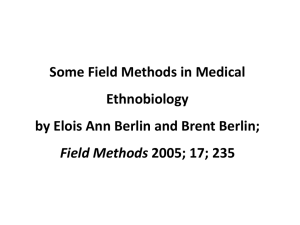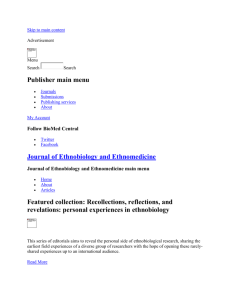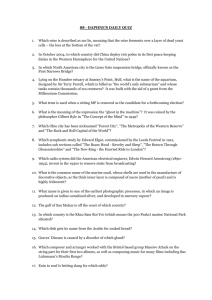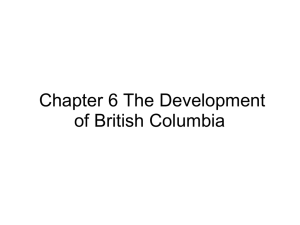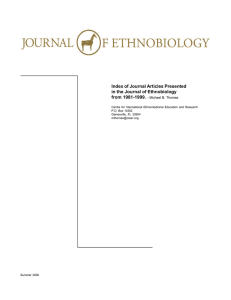HAINES_ethnobiblio - AIHEC STEM Resources Portal
advertisement
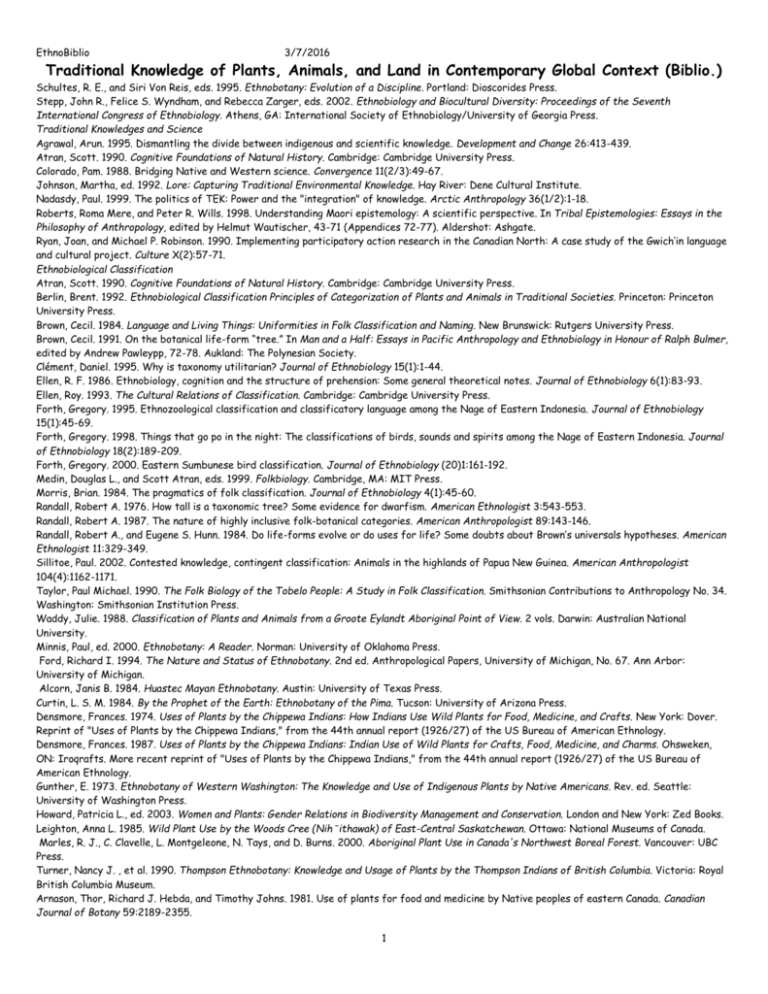
EthnoBiblio 3/7/2016 Traditional Knowledge of Plants, Animals, and Land in Contemporary Global Context (Biblio.) Schultes, R. E., and Siri Von Reis, eds. 1995. Ethnobotany: Evolution of a Discipline. Portland: Dioscorides Press. Stepp, John R., Felice S. Wyndham, and Rebecca Zarger, eds. 2002. Ethnobiology and Biocultural Diversity: Proceedings of the Seventh International Congress of Ethnobiology. Athens, GA: International Society of Ethnobiology/University of Georgia Press. Traditional Knowledges and Science Agrawal, Arun. 1995. Dismantling the divide between indigenous and scientific knowledge. Development and Change 26:413-439. Atran, Scott. 1990. Cognitive Foundations of Natural History. Cambridge: Cambridge University Press. Colorado, Pam. 1988. Bridging Native and Western science. Convergence 11(2/3):49-67. Johnson, Martha, ed. 1992. Lore: Capturing Traditional Environmental Knowledge. Hay River: Dene Cultural Institute. Nadasdy, Paul. 1999. The politics of TEK: Power and the "integration" of knowledge. Arctic Anthropology 36(1/2):1-18. Roberts, Roma Mere, and Peter R. Wills. 1998. Understanding Maori epistemology: A scientific perspective. In Tribal Epistemologies: Essays in the Philosophy of Anthropology, edited by Helmut Wautischer, 43-71 (Appendices 72-77). Aldershot: Ashgate. Ryan, Joan, and Michael P. Robinson. 1990. Implementing participatory action research in the Canadian North: A case study of the Gwich’in language and cultural project. Culture X(2):57-71. Ethnobiological Classification Atran, Scott. 1990. Cognitive Foundations of Natural History. Cambridge: Cambridge University Press. Berlin, Brent. 1992. Ethnobiological Classification Principles of Categorization of Plants and Animals in Traditional Societies. Princeton: Princeton University Press. Brown, Cecil. 1984. Language and Living Things: Uniformities in Folk Classification and Naming. New Brunswick: Rutgers University Press. Brown, Cecil. 1991. On the botanical life-form “tree.” In Man and a Half: Essays in Pacific Anthropology and Ethnobiology in Honour of Ralph Bulmer, edited by Andrew Pawleypp, 72-78. Aukland: The Polynesian Society. Clément, Daniel. 1995. Why is taxonomy utilitarian? Journal of Ethnobiology 15(1):1-44. Ellen, R. F. 1986. Ethnobiology, cognition and the structure of prehension: Some general theoretical notes. Journal of Ethnobiology 6(1):83-93. Ellen, Roy. 1993. The Cultural Relations of Classification. Cambridge: Cambridge University Press. Forth, Gregory. 1995. Ethnozoological classification and classificatory language among the Nage of Eastern Indonesia. Journal of Ethnobiology 15(1):45-69. Forth, Gregory. 1998. Things that go po in the night: The classifications of birds, sounds and spirits among the Nage of Eastern Indonesia. Journal of Ethnobiology 18(2):189-209. Forth, Gregory. 2000. Eastern Sumbunese bird classification. Journal of Ethnobiology (20)1:161-192. Medin, Douglas L., and Scott Atran, eds. 1999. Folkbiology. Cambridge, MA: MIT Press. Morris, Brian. 1984. The pragmatics of folk classification. Journal of Ethnobiology 4(1):45-60. Randall, Robert A. 1976. How tall is a taxonomic tree? Some evidence for dwarfism. American Ethnologist 3:543-553. Randall, Robert A. 1987. The nature of highly inclusive folk-botanical categories. American Anthropologist 89:143-146. Randall, Robert A., and Eugene S. Hunn. 1984. Do life-forms evolve or do uses for life? Some doubts about Brown’s universals hypotheses. American Ethnologist 11:329-349. Sillitoe, Paul. 2002. Contested knowledge, contingent classification: Animals in the highlands of Papua New Guinea. American Anthropologist 104(4):1162-1171. Taylor, Paul Michael. 1990. The Folk Biology of the Tobelo People: A Study in Folk Classification. Smithsonian Contributions to Anthropology No. 34. Washington: Smithsonian Institution Press. Waddy, Julie. 1988. Classification of Plants and Animals from a Groote Eylandt Aboriginal Point of View. 2 vols. Darwin: Australian National University. Minnis, Paul, ed. 2000. Ethnobotany: A Reader. Norman: University of Oklahoma Press. Ford, Richard I. 1994. The Nature and Status of Ethnobotany. 2nd ed. Anthropological Papers, University of Michigan, No. 67. Ann Arbor: University of Michigan. Alcorn, Janis B. 1984. Huastec Mayan Ethnobotany. Austin: University of Texas Press. Curtin, L. S. M. 1984. By the Prophet of the Earth: Ethnobotany of the Pima. Tucson: University of Arizona Press. Densmore, Frances. 1974. Uses of Plants by the Chippewa Indians: How Indians Use Wild Plants for Food, Medicine, and Crafts. New York: Dover. Reprint of "Uses of Plants by the Chippewa Indians," from the 44th annual report (1926/27) of the US Bureau of American Ethnology. Densmore, Frances. 1987. Uses of Plants by the Chippewa Indians: Indian Use of Wild Plants for Crafts, Food, Medicine, and Charms. Ohsweken, ON: Iroqrafts. More recent reprint of "Uses of Plants by the Chippewa Indians," from the 44th annual report (1926/27) of the US Bureau of American Ethnology. Gunther, E. 1973. Ethnobotany of Western Washington: The Knowledge and Use of Indigenous Plants by Native Americans. Rev. ed. Seattle: University of Washington Press. Howard, Patricia L., ed. 2003. Women and Plants: Gender Relations in Biodiversity Management and Conservation. London and New York: Zed Books. Leighton, Anna L. 1985. Wild Plant Use by the Woods Cree (Nih¯ithawak) of East-Central Saskatchewan. Ottawa: National Museums of Canada. Marles, R. J., C. Clavelle, L. Montgeleone, N. Tays, and D. Burns. 2000. Aboriginal Plant Use in Canada's Northwest Boreal Forest. Vancouver: UBC Press. Turner, Nancy J. , et al. 1990. Thompson Ethnobotany: Knowledge and Usage of Plants by the Thompson Indians of British Columbia. Victoria: Royal British Columbia Museum. Arnason, Thor, Richard J. Hebda, and Timothy Johns. 1981. Use of plants for food and medicine by Native peoples of eastern Canada. Canadian Journal of Botany 59:2189-2355. 1 EthnoBiblio 3/7/2016 Etkin, Nina L., ed. 1986. Plants in Indigenous Medicine and Diet: Biobehavioral Approaches. Bedford Hills, NY: Redgrave Publishing Company. Etkin, Nina L., ed. 1994. Eating on the Wild Side: The Pharmacologic, Ecologic, and Social Implications of Using Non-Cultigens. Tucson: University of Arizona Press. Johns, Timothy. 1990. With Bitter Herbs They Shall Eat It: Chemical Ecology and the Origins of Human Food and Medicine. Tucson: University of Arizona Press. Johnson Gottesfeld, Leslie M. 1995. The role of plant foods in traditional Wet’suwet’en nutrition. Ecology of Food and Nutrition 34:149-169. Kindscher, Kelly. 1987. Edible Wild Plants of the Prairie: An Ethnobotanical guide. Lawrence: University Press of Kansas. Kuhnlein, Harriet V., and Nancy J. Turner. 1991. Traditional Plant Foods of Canadian Indigenous Peoples: Nutrition, Botany and Use. Vol. 8 of Food and Nutrition in History and Anthropology. Philadelphia: Gordon and Breach Science Publishers. Minnis, Paul E. 1991. Famine foods of the North American desert borderlands in historical context. Journal of Ethnobiology 11:231-257. Muenchrath, Deborah A., Maya Kuratomi, Jonathan A. Sandor, and Jeffrey A. Homburg. 2002. Observational study of maize production systems of Zuni farmers in semiarid New Mexico. Journal of Ethnobiology 22(1):1-33. Nabhan, Gary Paul. 1989. Enduring Seeds: Native American Agriculture and Wild Plant Conservation. San Francisco: North Point Press. Solieri, Daniela, and David A. Cleveland. 1993. Hopi crop diversity and change. Journal of Ethnobiology 13(2):203-231. Stahl, Ann Brower. 1989. Plant-food processing: Implications for dietary quality. In Foraging and Farming: The Evolution of Plant Exploitation, edited by D. R. Harris and G. C. Hillman, 171-194. London: Unwin Hyman. Steinberg, Michael K. 2002. The globalization of a ceremonial tree: The case of cacao (Theobroma cacao) among the Mopan Maya. Economic Botany 56(1):58-65. Turner, Nancy J. 1995. Food Plants of Coastal First Peoples. A Royal British Columbia Museum Handbook. Vancouver: University of British Columbia Press. Turner, Nancy J. 1997. Food Plants of Interior First Peoples. A Royal British Columbia Museum Handbook. Vancouver: University of British Columbia Press. Arnason, Thor, Richard J. Hebda, and Timothy Johns. 1981. Use of plants for food and medicine by Native peoples of eastern Canada. Canadian Journal of Botany 59:2189-2355. Bastien, Joseph William. 1987. Healers of the Andes: Kallawaya Herbalists and Their Medicinal Plants. Salt Lake City: University of Utah Press. Blaxton, James D., II, Ara Der Marderosian, and Ron Gibbs. 2002. Bioactive constitutents of Alaskan devil's root (Oplopanax horridus, Araliaceae). Economic Botany 56(3):285-289. Hersch-Martinez, Paul. 1995. Commercialization of medicinal plants from southwest Puebla, Mexico. Economic Botany 49:197-206. Johns, Timothy, J. O. Kokwaro, and E. K. Kimanani. 1990. Herbal remedies of the Luo of Siaya District, Kenya: Establishing quantitative criteria for consensus. Economic Botany 44(3):369-381. Johns, Timothy, E. B. Mhoro, Pius Sanaya, and Ebi K. Kimanani. 1994. Herbal remedies of the Batemi of Ngorongoro District, Tanzania: A quantitative appraisal. Economic Botany 48(1):90-95. Lewis, W. H., and M. P. F. Elwin-Lewis. 1977. Medical Botany. New York: Wiley-Interscience. McCutcheon, A. R., S. M. Ellis, R. E. W. Hancock, and G. H. Towers. 1992. Antibiotic screening of medicinal plants of the British Columbian Native peoples. Journal of Ethnopharmacology 37(3):213-223. McCutcheon, A. R., S. M. Ellis, R. E. Hancock, and G. H. Towers. 1994. Antifungal screening of medicinal plants of British Columbian Native peoples. Journal of Ethnopharmacology 44(3):157-169. McCutcheon, A. R., T. E. Roberts, E. Gibbons, S. M. Ellis, L. A. Babiuk, R. E. Hancock, and G. H. Towers. 1995. Antiviral screening of British Columbian medicinal plants. Journal of Ethnopharmacology 49(2):101-110. Moerman, Daniel E. 1998. Native American Ethnobotany. Portland: Timber Press. Ritch-Krc, Elizabeth M., Nancy J. Turner, and G. H. Towers. 1996. Carrier herbal medicine: An evaluation of antimicrobial and anticancer activity in some frequently used remedies. Journal of Ethnopharmacology 52(3):151-156. Ritch-Krc, Elizabeth M., Sophie Thomas, Nancy J. Turner, and G. H. Towers. 1996. Carrier herbal medicine: Traditional and contemporary plant use. Journal of Ethnopharmacology 52(2):85-94. Schultes, R. E., and Albert Hofmann. 1992. Plants of the Gods: Their Sacred, Healing and Hallucinogenic Powers. Rochester, VT: Healing Arts Press. Schultes, Richard Evans, and Robert F. Raffauf. 1990. The Healing Forest: Medicinal and Toxic Plants of the Northwest Amazonia. Portland: Dioscorides Press. Sheldon, Jennie Wood, Michael J. Balick, and Sarah A. Liard. 1997. Medicinal Plants: Can Utilization and Conservation Coexist? Vol. 12 of Advances in Economic Botany. Bronx: New York Botanic Garden. Smith, G. W. 1983. Arctic Pharmacognosia II: Devil's club, Oplopanax horridus. Journal of Ethnopharmacology 7:313-320. Smith, Harlan I. 1997. Ethnobotany of the Gitksan Indians of British Columbia, edited by Brian Compton, Bruce Rigsby, and Marie-Lucie Tarpent. Mercury Series Paper 132, Canadian Ethnology Service. Hull, QC: Canadian Museum of Civilization. Emmons, George Thornton. 1993. The Basketry of the Tlingit; and The Chilkat Blanket; With Revised Appendices by Nora Marks Dauenhauer ... [et al.]. Sitka, AK: Friends of the Sheldon Jackson Museum for the Sheldon Jackson Museum, Division of Libraries, Archives, and Museums, State of Alaska. (First work originally published in 1903, second work published in 1907.) Gilmore, Michael P., W. Hardy Eshbaugh, and Adolph M. Greenberg. 2002. The use, construction, and importance of canoes among the Maijuna of the Peruvian Amazon. Economic Botany 56(1):10-26. Guujaaw. 1984. The Cedar. Vancouver: Wedge. La Foret, A. 1984. Tsimshian basketry. In The Tsimshian: Images of the Past, Views for the Present, edited by M. Seguin, 215-280. Vancouver: University of British Columbia Press. Milliken, William, and Bruce Albert. 1997. Construction of a Yanomami round-house. Journal of Ethnobiology 17(2):215-233. Samuel, Cheryl. 1982. The Chilkat Dancing Blanket. Seattle: Pacific Search Press. 2 EthnoBiblio 3/7/2016 Stewart, H. 1984. Cedar: Tree of Life to the Northwest Coast Indians. Vancouver: Douglas and McIntyre. Stewart, Hilary. 1977. Indian Fishing: Early Methods on the Northwest Coast. Vancouver: Douglas & McIntyre/Seattle: University of Washington Press. Turner, Nancy J. 1998. Plant Technology of First Peoples in British Columbia. Vancouver: UBC Press. Wheat, Margaret M. 1967. Survival Arts of the Primitive Paiutes. Reno: University of Nevada Press. Ethnozoology Black, Lydia T. 1998. Animal world of the Aleuts. Arctic Anthropology 35(2):126-135. Bodenham, Barbara. 1993. Gendered spaces, public places: Public and private revisited on the north slope of Alaska. In Landscape, Politics and Perspectives, edited by Barbara Bender, 169-203. Oxford: Berg. Bødker Enghoff, Inge. 2003. Hunting, Fishing and Animal Husbandry at The Farm Beneath The Sand, Western Greenland. With chapter on archaeological background by Jette Arneborg. Meddelelser om Groenland. Man & Society 28. Copenhagen: Danish Polar Centre. Felger, Richard Stephen, and Mary Beck Moser. 1985. People of the Desert and the Sea: Ethnobotany of the Seri Indians. Tucson: University of Arizona Press. Gilmore, Melvin R. 1987. Prairie Smoke. St. Paul: Minnesota Historical Society Press. Gilmore, Melvin R. 1991. Uses of Plants by the Indians of the Missouri River Region. Lincoln: University of Nebraska Press. Gwich'in Elders. 2001. Gwìndòo Nành' Kak Geenjit Gwich'in Ginjik: More Gwich'in Words About the Land. Inuvik: Gwich'in Renewable Resource Board. Gwich’in Elders and G. Raygorodetsky. 1997. Nành' Kak Geenjit Gwich'in Ginjik: Gwich'in Words About the Land. Inuvik: Gwich'in Renewable Resource Board. Hamblin, Nancy L. 1984. Animal Use by the Cozumel Maya. Tucson: University of Arizona Press. Rea, Amadeo M. 1998. Folk Mammalogy of the Northern Pimans. Tucson: University of Arizona Press. Stewart, Hilary. 1977. Indian Fishing: Early Methods on the Northwest Coast. Vancouver: Douglas & McIntyre/Seattle: University of Washington Press. Winterhalder, Bruce, and Eric Alden Smith, eds. 1982. Hunter-Gatherer Foraging Strategies. Chicago: University of Chicago Press. Uses of Animals in Technology and Technology for Obtaining Animals Emmons, G. T. 1911. The Tahltan Indians. Vol. 4.1 of Anthrological Publications. Philadelphia: The University [of Pennsylvania] Museum. Felger, Richard Stephen, and Mary Beck Moser. 1985. People of the Desert and the Sea: Ethnobotany of the Seri Indians. Tucson: University of Arizona Press. Fowler, Catherine S. 1992. In the Shadow of Fox Peak: An Ethnography of the Cattail-Eater Northern Paiute People of Stillwater Marsh. No. 5 in the Cultural Resource Series. Region 1, Stillwater National Wildlife Refuge: US Department of the Interior, Fish and Wildlife Service. Gustavson, Paula. 1980. Salish Weaving. Vancouver: Douglas & McIntyre. Morice, A. G. 1893. Notes Archaeological, Industrial and Sociological of the Western Dénés, with an Ethnographical Sketch of the Same. In Vol. 3 of Transactions of the Canadian Institute, Session 1892-1893. Oakes, Jill E. 1992. Eider skin garments used by the Ungava Unuit from the Belcher Islands, Northwest Territories: Construction and context. Clothing and Textiles Research Journal, 10(2):1-10. Oakes, Jill E., and Paula Gustafson. 1991. Coats of Eider: From the Ungava Inuit of the Belcher Islands. Scottsdale, AZ: American Indian Art, Inc. Oakes, Jill E., and Rick Riewe. 1992. A Comparison of Historical and Contemporary Skin Clothing Used in North Greenland: An Ethnohistorical Approach. Edmonton: University of Alberta, Department of Clothing and Textiles. Oakes, Jill E., and Rick Riewe. 1995. Our Boots: An Inuit Women's Art. Vancouver: Douglas & McIntyre. Oakes, Jillian E. 1991. Copper and Caribou Inuit Skin Clothing Production. Hull, QC: Canadian Museum of Civilization. Samuel, Cheryl. 1982. The Chilkat Dancing Blanket. Seattle: Pacific Search Press. Samuel, Cheryl. 1987. The Raven's Tail. Vancouver: University of British Columbia Press. Sturtevant, William C., ed. 1978-. Handbook of North American Indians. Washington: Smithsonian Institution. Tom, Gertie. 1981. Dùts’um Edhó Ts’ètsi Yu Dän K’í: How to Tan Hides in the Native Way. Whitehorse: Council for Yukon Indians. Barbeau, Marius. 1990. Totem Poles. Hull, QC: Canadian Museum of Civilization. Brightman, Robert. 1993. Grateful Prey: Rock Cree Human-Animal Relationships. Berkeley: University of California Press. Clutesi, George. 1975. Son of Raven, Son of Deer: Fables of the Tse-Shaht People. Sidney, BC: Gray's Publishers. Dauenhauer, Nora Marks, and Richard Dauenhauer. 1987. Haa Shuká, Our Ancestors: Tlingit Oral Narratives. Seattle: University of Washington Press/Juneau: Sealaska Heritage Foundation. Evers, Larry, and Felipe S. Molina. 1987. Yaqui Deer Songs, Maso Bwikam: A Native American Poetry. Tucson: University of Arizona Press. Garfield, Viola E., and Linn A. Forrest. 1961. The Wolf and the Raven: Totem Poles of Southeastern Alaska. Seattle: University of Washington Press. Harris, Kenneth B., and Frances M. P. Robinson. 1974. Visitors Who Never Left: The Origin of the People of Damelahamid. Vancouver: UBC Press. Jonaitis, Aldona. 1986. Art of the Northern Tlingit. Seattle: University of Washington Press. Miller, Jay. 1997. Tsimshian Culture: A Light Through the Ages. Lincoln: University of Nebraska Press. Moore, Patrick, and Angela Wheelock, eds. 1990. Wolverine Myths and Visions: Dene Traditions from Northern Alberta, compiled by the Dene Wodih Society. Edmonton: University of Alberta Press. Carriere, Stephanie. 2002. "Orphan trees of the forest": Why do Ntumu farmers of southern Cameroon protect trees in their swidden fields? Journal of Ethnobiology 22(1):133-162. Hamlin, Catherine C., and Jan Salick. 2003. Yanesha agriculture in the Upper Peruvian Amazon: Persistence and change fifteen years down the "road." Economic Botany 57(2):163-180. Muenchrath, Deborah A., Maya Kuratomi, Jonathan A. Sandor, and Jeffrey A. Homburg. 2002. Observational study of maize production systems of Zuni farmers in semiarid New Mexico. Journal of Ethnobiology 22(1):1-33. 3 EthnoBiblio 3/7/2016 Basso, Keith H. 1996. Wisdom Sits in Places: Landscape and Language among the Western Apache. Albuquerque: University of New Mexico Press. Berkes, Fikret. 1999. Sacred Ecology: Traditional Ecological Knowledge and Resource Management. Philadelphia: Taylor and Francis. Blackburn, Thomas C., and Kat Anderson, eds. 1993. Before the Wilderness: Environmental Management by Native Californians. Menlo Park: Ballena Press. Carriere, Stephanie. 2002. "Orphan trees of the forest": Why do Ntumu farmers of southern Cameroon protect trees in their swidden fields? Journal of Ethnobiology 22(1):133-162. Davidson-Hunt, Iain, and Fikret Berkes. 2003. Learning as you journey: Anishinaabe perception of social-ecological environments and adaptive learning. Conservation Ecology 8(1). Descola, Philippe, and Gísli Pálsson. 1996. Nature and Society: Anthropological Perspectives. London: Routledge. Ellen, Roy, and Katsuyoshi Fukui, eds. 1996. Redefining Nature: Ecology, Culture and Domestication. Oxford: Berg. Escobar, Arturo. 1999. After nature. Current Anthropology 40(1):1-30. Johnson, Leslie Main. 2000. "A place that’s good": Gitksan landscape perception and ethnoecology. Human Ecology 28(2):301-325. Kawagley, Oscar A. 1995. A Yupiaq Worldview: A Pathway to Ecology and Spirit. Prospect Heights, IL: Waveland. Milton, Kay. 2002. Loving Nature: Towards an Ecology of Emotion. London: Routledge. Nelson, Richard K. 1983. Make Prayers to the Raven: A Koyukon View of the Northern Forest. Chicago: University of Chicago Press. Nelson, Richard K. 1986. Hunters of the Northern Forest: Designs for Survival Among the Alaskan Kutchin. Chicago: University of Chicago Press. Boyd, Robert, ed. 1999. Indians, Fire, and the Land in the Pacific Northwest. Corvallis: Oregon State University Press. Carriere, Stephanie. 2002. "Orphan trees of the forest": Why do Ntumu farmers of southern Cameroon protect trees in their swidden fields? Journal of Ethnobiology 22(1):133-162. Cruikshank, J. 1998. The Social Life of Stories: Narrative and Knowledge in the Yukon Territory. Vancouver: UBC Press. Ellen, Roy, Peter Parkes, and Alan Bicker. 2000. Indigenous Environmental Knowledge and Its Transformations: Critical Anthropological Perspectives. Amsterdam: Harwood Academic. Inglis, Julian T. 1993. Traditional Ecological Knowledge: Concepts and Cases. Ottawa: International Development Research Centre and International Program on Traditional Ecological Knowledge. Lantz, Trevor C., and Nancy J. Turner. 2003. Traditional phenological knowledge of Aboriginal peoples in British Columbia. Journal of Ethnobiology 23(2):263-286. Lewis, Henry T. 1982. A Time for Burning. Occasional Publication No. 17. Edmonton: Boreal Institute for Northern Studies, University of Alberta. http://aupac.lib.athabascau.ca/search/t?SEARC H=time+for+burning Scott, Colin. 1996. Science for the West, myth for the rest? The case of James Bay Cree knowledge construction. In Naked Science: Anthropological Inquiry into Boundaries, Power, and Knowledge, edited by Laura Nader, 69-86. London: Routledge. Trawick, Paul. 2002. Trickle-down theory, Andean Style. Natural History 111(8):60-65. Turner, Nancy J., Marianne Boelscher Ignace, and Ronald Ignace. 2000. Traditional ecological knowledge and wisdom of Aboriginal peoples in British Columbia. Ecological Applications 10(2):1275-1287. Anderson, Eugene. 1996. Ecologies of the Heart: Emotion, Belief and the Environment. Oxford: Oxford University Press. Berkes, Fikret. 1989. Common Property Resources: Ecology and Community-Based Sustainable Development. London: Belhaven Press. Berkes, Fikret, and Carl Folke. 1998. Linking Social and Ecological Systems: Management Practices and Social Mechanisms for Building Resilience. Cambridge: Cambridge University Press. Dwyer, Peter. 1994. Modern conservation and indigenous peoples: In search of wisdom. Pacific Conservation Biology 1:91-97. Fienup-Riordan, Ann. 1999. Yaqulget Qaillum Pilartat (what the birds do): Yup’ik Eskimo understanding of geese and those who study them. Arctic 52(1):1-22. Johnson Gottesfeld, Leslie M. 1994. Conservation, territory and traditional beliefs: An analysis of Gitksan and Wet’suwet’en subsistence, Northwest British Columbia, Canada. Human Ecology 22(4):443-465. Ostrom, E., Tom Dietz, Nives Dolsak, Paul C. Stern, Susan Stomich, and Elke U. Weber, eds. 2002. The Drama of the Commons. Washington, DC: National Academy Press. Pinkerton, Evelyn. 1989. Co-operative Management of Local Fisheries: New Directions for Improved Management and Community Development. Vancouver: University of British Columbia Press. Roberts, Mere, Waerete Norman, Nganeko Minkinnick, Del Wihongi, and Carmen Kirkwood. 1995. Kaitiakitanga: Maori perspectives on conservation. Pacific Conservation Biology 2(1):7-20. Freese, Curtis H. 1997. Harvesting Wild Species: Implications for Biodiversity. Baltimore: Johns Hopkins University Press. Laird, Sarah, ed. 2002. Biodiversity and Traditional Knowledge: Equitable Partnerships in Practice. In the People and Plants Conservation Series. London: Earthscan Publications, Ltd. Maffi, Luisa, ed. 2001. On Biocultural Diversity: Linking Language, Knowledge, and the Environment. Washington, DC: Smithsonian Institution Press. Minnis, Paul E., and Wayne J. Elisens. 2000. Biodiversity and Native America. Norman: Universitiy of Oklahoma Press. Brush, Stephen B., and Doreen Stabinsky, eds. 1996. Valuing Local Knowledge: Indigenous People and Intellectual Property Rights. Washington, DC: Island Press. Grenier, Louise. 1998. Working with Indigenous Knowledge. Ottawa: International Development Research Centre. Posey, Darrell A., and Graham Dutfield. 1996. Beyond Intellectual Property: Toward Traditional Resource Rights for Indigenous Peoples and Local Communities. Ottawa: International Development Research Centre. 4
